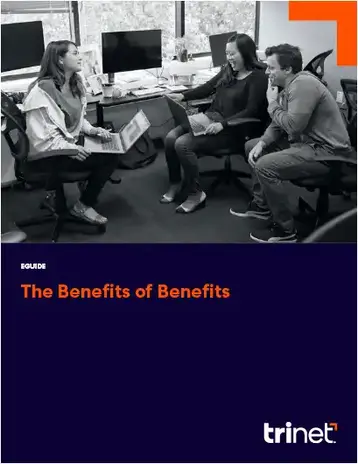
In the past, salary was arguably the sole reason job seekers choose certain positions or sought after specific companies. Today, things are starting to change. While salary is still an essential component of securing high-quality candidates, it’s not enough to keep those talented individuals happy. In fact, when asked, 80% of employees said that they would prefer additional benefits over a pay increase. So, what types of benefits are employees interested in and how do small to medium-size businesses (SMBs) choose the best options for their team? First, it’s important to understand employee fringe benefits and some of the legalities involved.
What Are Employee Fringe Benefits?
Employee fringe benefits are supplemental or ancillary benefits given to employees in addition to their salary or compensation. They can be given to all employees, certain tiers of management or they can be given as rewards for a job well done. There are several distinctive levels of fringe benefits, each of which can be used for motivation or employee retention.
Types of Employee Fringe Benefits
Employee fringe benefits can include health insurance, retirement plans, flexible work arrangements, paid time off, wellness programs and other forms of assistance. By offering a comprehensive package of fringe benefits, a company demonstrates its commitment to the overall welfare of its employees, showing that they are valued and cared for. Aside from a few benefits that are required by law, fringe benefits can be determined completely by the company and don’t have many restrictions. For example, Ben & Jerry’s offers each employee three free ice cream pints per day while Airbnb provides their employees with a travel and experiences stipend. To better understand your options, consider some of the diverse types of employee fringe benefits and what they involve.
Health Insurance and Medical Leave
One of the most important benefits in the U.S. is health insurance. According to a survey by Glassdoor, employees said health insurance is, by far, the most important benefit they receive from their employer. Thanks to the Patient Protection and Affordable Care Act (ACA), all businesses with an average of more than 50 employees need to provide a healthcare plan that offers a minimum level of health insurance coverage to its workforce or potentially pay a penalty. This usually includes visits to primary care physicians, certain specialists and any type of emergency care. Medical leave covered by the Family and Medical Leave Act (FMLA) is unpaid, however can last up to 12 weeks without punishment from the employer.
Businesses can offer additional coverage options including vision, dental, life insurance and flexible spending accounts. Although much smaller companies (less than 50 employees) aren’t necessarily legally required to provide their team with coverage, there are still many benefits in doing so.
Retirement Plans
Pension payments are legally required to be deducted from employee paychecks in the form of social security, but additional retirement plans aren’t. About 60% of Americans are currently living paycheck to paycheck, which can put a lot of stress on employees when considering their long-term outlook. Companies that offer their team a 401(k) or other type of retirement plan can help attract new hires who are interested in long-term financial freedom. There are various options for how you can set up retirement plans, but working with a professional employer organization (PEO) can help.
Wellness Programs
One of the more up-and-coming employee fringe benefits are wellness programs or packages. This may include things like gym memberships, discounts for massages, mental health support and more. It could also include incentives to stay fit, eat healthy and maintain a healthy weight. Although there needs to be care in how these types of motivational programs are approached, several companies include wellness options in their fringe benefits.
Paid Time Off
PTO is also considered an employee fringe benefit and is actually not mandatory on a federal level in the U.S. However, most businesses create PTO policies that include about 10 days, which would allow for two weeks of vacation. With that being said, many prospects are now looking for jobs that offer a better work-life balance, like European workers have. Therefore, you may want to consider making an attractive PTO policy available for high-performing employees.
Other Non-Traditional Benefits
Additional employee fringe benefits can include things like remote work options, flexible schedules, commuting benefits, transportation costs, compensation for childcare, compensation for pet sitting or doggy daycare, free lunches, office drinks and snacks or anything else you can think of. The opportunities are truly endless, as demonstrated by Ben & Jerry’s unique approach with the free ice cream.
Regardless of which fringe benefits you choose to offer, it’s important to work with an HR professional to understand how to value them, determine which ones are taxable and how to conform to the IRS rules that surround them. Most fringe benefits are subject to income tax withholding and employment taxes but are tax-exempt for the employer. For more information, consider the Employer’s Tax Guide to Fringe Benefits by the IRS.
Certain Benefits Are Mandatory
Occasionally mistaken as fringe benefits, there are two important benefit types that are mandated by law:
Workers’ Compensation
The Department of Labor also has made workers’ compensation a mandatory fringe benefit to federal workers. This covers any injuries or accidents that occur onsite, or in the case of contracting an occupational disease. There are variations depending on which state you live in, so it’s important to check your local laws and regulations to ensure that you’re providing employees with adequate coverage.
Unemployment Insurance
Another mandatory employee fringe benefit is unemployment insurance. This allows individuals who have lost their job (due to outside circumstances, not misconduct or neglect) to collect financial compensation while they search for new employment opportunities. This is protected under the Federal Unemployment Tax Act (FUTA) and is mandatory for businesses of all sizes.
Workers’ comp and unemployment insurance are not to be confused with other fringe benefits that are not required.
Advantages of Employee Fringe Benefits
As an SMB owner, you may be wondering what advantages there are to offering an attractive package of employee fringe benefits. Fringe benefits go beyond basic salary and provide additional perks and incentives that contribute to employee satisfaction and well-being. This not only helps attract skilled professionals but also boosts employee loyalty and engagement, leading to increased productivity, reduced turnover and a more harmonious workplace.
Moreover, fringe benefits can differentiate a company from its competitors in the job market, giving it a competitive edge in attracting and retaining top talent. Ultimately, investing in fringe benefits is a wise decision for any company looking to create a positive work culture and achieve long-term success. Although some benefits can seem unnecessary or unconventional, you’d be surprised at the impact they can have.
Consider some of the best reasons to expand your employee fringe benefits:
Attract Top Talent and High-Quality Employees
One of the biggest benefits of having a good package for your employees is that it helps to attract top talent and high-quality prospects. With an increasingly competitive job market, this is a great way to secure a team that will help you achieve your short- and long-term business goals.
Improve Employee Retention
Employees who are satisfied with their benefits are also less likely to look elsewhere for new opportunities. This increases overall employee retention and helps you avoid wasted money on revolving doors with onboarding and offboarding.
Enhance Employee Productivity
If you offer specific fringe benefits based on performance, you’ll likely notice employee productivity levels increase. People will put in the extra work when they know they’ll be compensated for it.
Demonstrate Company Values and Culture
Finally, offering certain employee fringe benefits can help you demonstrate your commitment to your company’s values and culture. It shows that you’re invested in your team and happy to reward them for their role in your organization.
How to Choose the Right Employee Benefits Package
As an employer, it’s up to you to determine which fringe benefits are offered, which employees are eligible to receive them and how much of each benefit is offered. This can make choosing the right benefits a bit overwhelming, but it’s still worth the effort.
To help, consider the following tips.
Determine Employee Needs and Preferences
Before you start going through the list of options, consider what your employees would benefit most from. Try to compare your overall company culture with who you would view as a top-employee and consider what would make their life better. If you’re a retail store that wants to maintain a certain high-end image, offering personal wardrobe compensation might be better than commuting options. You could also get an idea of what your team wants by administering an employee feedback survey or asking for ideas.
Evaluate the Costs and Benefits of Different Packages
As mentioned, some fringe benefits are taxable, while others are non-taxable. Therefore, you’ll want to determine the various costs versus benefits of different packages for employees, especially as an SMB. Try to determine what your employees would benefit most from, then partner with an HR professional to better understand your options, the costs associated and how to make the most out of your investments.
There are several great reasons to offer your team employee fringe benefits, but as an SMB it can be logistically and financially difficult. That’s why TriNet offers full-service HR solutions to SMBs across various industries. Call us today to learn more about our big company benefits and how they can help you attract and retain top talent.






